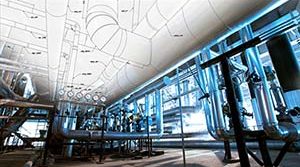Tag: product testing
June 2001 News: Issue 1
PT&P Verifies New Designs for LNG Phenolic Base Support with Load Testing

Piping Technology & Products, Inc. performs thorough product testing to verify new designs to a LNG Laminated Phenolic base support for an E&C company located in Houston, Texas. In order to determine the failure loads for a 30″ diameter, pre-insulated shoes and a 6″ diameter Laminated Phenolic base support respectively, PT&P performed lateral-load and axial load tests. The load tests performed ensure the pre-insulated pipe shoes can safely sustain the specified design load. The insulated shoes tested for the E&C company will be in service in 2001 at Atlantic LNG, where they will be used to support the liquid nitrogen gas (LNG) lines.
Big Ton Springs Installation Guide
 1. Measure the existing installed load setting height to make sure that the big ton spring will fit tightly into the space provided. Shim from below as needed to ensure proper fit.
1. Measure the existing installed load setting height to make sure that the big ton spring will fit tightly into the space provided. Shim from below as needed to ensure proper fit.
2. Place the big ton spring in the designated location, making sure that all required slide plates, shims, or auxiliary steel are in their proper positions.
3. Travel stop bolts can be released after all testing has been done. The travel stops are painted red and located on each end of the big ton spring. Follow the steps below to release the travel bolt stops. Please refer to the drawings to the left.
(a) Turn the nut on travel stop bolt No. 1 one-half turn; repeat on bolts 2 through 4.
(b) Repeat in this sequential order until the load is released. The load has now been transferred to whatever the big ton spring is supporting.
4. CAUTION: Be sure that the nuts on the travel stop bolts are backed off enough to accommodate the appropriate travel (Example: 1 inch of travel – the nuts should be backed off by 2 inches from the bottom of the travel stop plate.)
5. At this time the Lifting Eye Bolts may be removed.
Tension Systems
In some cases, a straight line system of axial bellows anchors and guides is not practical or desired; or there is no reasonable way/ place to anchor the bellows thrust loads. In such cases self restrained bellows assemblies may be used, such as the double hinge restrained bellows shown below. Thermal expansion (or contraction) in the long pipe is absorbed by an offset deflection of the double hinge assembly. Bellows thrust load is carried by hinge bars, gimbals, tie rods or other such devices; hence normal tension is maintained in the pipe system and main anchors and full lateral restraint guides are unnecessary.
PT&P Aids in the Creation of the "Chemical Island"
Piping Technology & Products, Inc. supplied more than 3,000 cold shoes, 400 slide plates and numerous more spring hangers, constants and fabricated pipe supports for the construction of a refinery plant on Jurong Island, Singapore. U.S. Bellows, Inc., also supplied many of the expansion joints used in the creation of this refinery.
Jurong Island is a man-made island consisting of four petroleum refineries, 30 petrochemical firms, and many more industrial firms to support its existence.
Tips on Corrosion Protection
There are four methods of protecting carbon steel pipe support components from corrosion; painting, zinc coatings, hot dip galvanizing, and combinations of these. Painting has an advantage when appearance and choice of color are important. Modern painting systems may be appropriate protection in certain environments. Paint provides a barrier protection to a metal surface. The ability of zinc to provide cathodic protection for carbon steel in addition to barrier protection is a fundamental advantage. In most cases the reduction in life-cycle costs justifies the small additional cost of galvanizing. Indeed painting and galvanizing together can provide a synergistic benefit which may be justified in some cases. For more information on corrosion, refer to https://pipingtech.com/resources/technical-bulletins/corrosion-protection/
PT&P’s Diverse Product Testing
Piping Technology & Products, Inc. is a recognized leader in pipe supports, pre-insulated pipe supports, miscellaneous fabrication and expansion joints and has extensive experience with several different types of product testing. This includes :
* Load Testing : The objective of the load test is to determine the maximum load for pipe supports and other products. Load tests are done on an assortment of pipe supports.
* Snubber Testing : The objective of the snubber cycle test is to (1) display the normal wear and tear for a snubber over an extended period of time, and (2) display the resistance to an abrupt disturbance.
* Burst Testing : The objective of the burst test is to determine the ultimate pressure resistance. Primarily conducted on bellows.
See more about testing on our site: Product Testing
PT&P Acquires Mobile Test Facility for Snubbers
In addition to the snubber test equipment obtained from Basic Engineers, PT&P has purchased a mobile snubber test facility from Commonwealth Edison, an electric utility in Illinois. The mobile snubber test trailer was in use at ComEd’s La Salle Nuclear facility.
This snubber test system is installed in a large truck trailer which was specifically designed to house a mobile test facility. The trailer is 47.5 feet long and is climate controlled with both heat and air conditioning. It has a one-ton crane that runs the length of the trailer and can be extended an additional 8 feet for loading and unloading snubbers. It also includes a small office.
The snubber test trailer contains test benches with a test capacity of 135,000 lbs. PT&P plans to begin providing field testing service to customers using this mobile facility.
Do you require snubbers for an upcoming project? Request a quote today!




